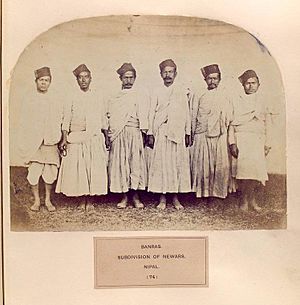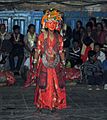Newar people facts for kids

Banras/Shakya Buddhist priests
|
|
| Total population | |
|---|---|
| 1,321,933 (5% of Nepal population) |
|
| Regions with significant populations | |
| Nepal | |
| Languages | |
| Newar and Nepali | |
| Religion | |
| Hinduism and Buddhism | |
| Related ethnic groups | |
| Nepal Mandala peoples; Maithils; Tibeto-Burman peoples; Other Indo-Aryan peoples |
The Newar people (also called Newars or Nepami) are a special group of people who have lived in the Kathmandu Valley and nearby areas of Nepal for a very long time. They are known for creating much of Nepal's amazing history and culture.
They built advanced cities and had different jobs for everyone. This kind of organized city life was quite unique in the Himalayan mountains. Newars are proud to keep their old traditions, religions, and culture alive. They see themselves as guardians of Nepal's heritage.
They speak a language called Nepal Bhasa. Most Newars follow either Hinduism or Buddhism. They are a mix of different groups, including those from Indo-Aryan and Tibeto-Burman backgrounds.
The Kathmandu Valley and its surrounding areas used to be the Newar kingdom called the Nepal Mandala. The Newar people are unique because they are a mix of many different groups. These groups have lived in the Nepal Mandala since ancient times.
Images for kids
-
The Vajji or Vṛji Mahajanapada and Malla Mahajanapada in 600 BCE; Notable Licchavi (kingdom) and Malla (Nepal) of Nepal Mandala originated from respective ones
-
Temple of Pashupatinath.
-
Swayambhunath in Kathmandu
See also
 In Spanish: Pueblo Newa para niños
In Spanish: Pueblo Newa para niños

















